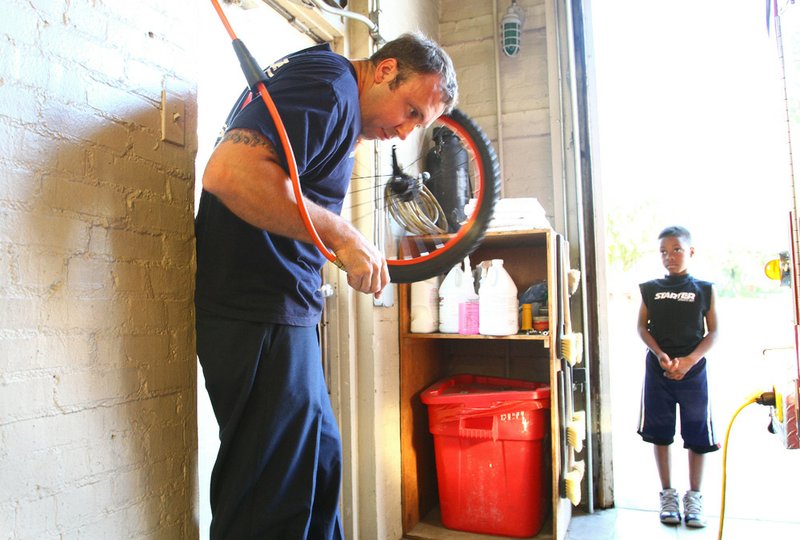LITTLE ROCK — Nestled under the shade of large oak trees at 22nd and Peyton streets is one of Little Rock’s smallest, oldest and yet busiest fire stations, Station Three.
“This station’s unique because it’s in a busy part of town but it’s the only neighborhood fire station,” firefighter Brian Quinn says about the station not much bigger than the homes it has served since 1945.
He explains the street’s layout: “It’s house, house, fire station, house. You just don’t see that very often in the middle of a neighborhood.”
You might not notice the building if you weren’t a neighbor. But if you were in a car wreck, or had a medical emergency, you’d soon be meeting the station’s firefighters face to face.
The busyness suits Quinn just fine.
“You get your hands on a lot of things, you get to fight a lot of fires and you get to make a lot of runs. You can really keep your head in the game, learning new stuff all the time.”
Quinn and firefighters Jenny Hyatt and Kelvin Brown, along with Capt. Roger Pool, make up B shift, working 24 hours on duty and 48 off. Station Three’s primary coverage area is roughly bordered by Woodrow Street and University Avenue on the east and west, Interstate 630 and Asher Avenue on the north and south. The area consists primarily of older, smaller residential structures. As with all Little Rock stations, their territory shifts as emergencies require.
A DAY’S WORK
In mid-March, Jamal Nelson, age 8, declared his own emergency. Outside the station’s front door is a push-button bell: “One long ring for emergencies, two short rings for a non-emergency.” The one long ring rang out and the four B shift members sprang quickly from their relaxation in the kitchen in the rear of the building.
There stood Jamal with a flat rear bicycle tire and a sad face. The firefighters corrected Jamal for using the long ring.
After attempting to inflate, Quinn had to break the bad news to him that his tire had a hole in it. Jamal bowed his head and walked out into the neighborhood sunset.
Six weeks later, on May 3, another call, this time from 911 dispatch. The call, “Unknown medical,” sounded routine. “Unknown medical” could represent problems as diverse as a broken toe or a fainting spell. They were the first medical aid on the scene at the small hill of the grassy lot near S. Oak and West 27th streets. The height of the fire engine cab gave the firefighters a clear view of the scene not visible from street level. Michael Stanley Jr., 14, lay motionless, halfway between the bumper of a minivan and a single-speed bike on its side.
Four B shift members, all with EMT certifications, worked quickly to stabilize Michael before the ambulance arrived. Quinn and Hyatt rode with Michael to Arkansas Children’s Hospital, where the teenager was pronounced dead. Police have said Michael snatched Michael Sadler’s wallet and fled on a bicycle. Sadler reportedly ran down the youth with his van and beat him. Sadler has been changed with first-degree murder.
Just an hour or so later a call came out: “Man bleeding in the street.” The firefighters would have been first on the scene, but they idled three or four blocks away while police secured the scene - standard operating procedure. Minutes ticked by, five, 10.
Finally the call from dispatch: “As per PD, you can disregard.” The engine returned to its station with no explanation. Such is the roller coaster of unexpected turns emergency workers deal with every day.
YEARS OF SERVICE
The station has seen a neighborhood in transition over its 67 years. One of its rougher periods in the gang violence of the early 1990s led to the installation of bulletproof glass in the front of the station. Now the neighborhood appears to be going through a rebirth, with new home construction and city efforts to tear down abandoned houses.
Lou Ethel Nauden, who has lived across the street from Station Three for 41 years, has seen the changes.
“That’s the one thing we have in terms of bragging rights for this neighborhood is Fire Station Three,” Nauden says. “The minute I see a firetruck, I look for the number and say, ‘Is that ours?”
Nauden has never needed their services in an emergency, but they’ve been to her home to check smoke alarms. “We have a lot of seniors that live in the area and they just know that when they call, our guys are going to be there.”
Nauden is also very proud of Hyatt, the station’s only female firefighter. “She’s a remarkable person. She does all kinds of stuff. I saw her with a power saw the other day cutting down the trees and all the guys standing around looking. I thought it was kind of funny.”
In the speckled early morning light at the start of their shift, Hyatt and Brown are greeted by the smiling face of a new neighbor. Signoret Colclough wanted to make sure B shift got some of the fresh vegetables she had dropped off at the station the previous day. She told them not to be surprised if she comes by with more produce grown by her and her father.
“She wanted to do something for the community, Brown says. “She saw the fire station and [said], ‘Well, this is what I can do.’”
Sitting on the wide chrome bumper of Engine Three, Quinn reflects on his statement about busyness.
“No one really understands when you want to be busy, because when we’re busy it means someone else is having a bad day,” he says. “You’re seeing the worst of times for some people. It’s not that we wish that on anybody.
“If those things are going to go on, I want to be there, part of it, part of the solution.”
Style, Pages 29 on 07/10/2012
